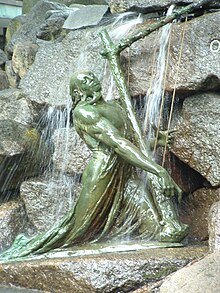Fossegrim, also known simply as the grim (Norwegian) or Strömkarlen (Swedish), is a water spirit or troll in Scandinavian folklore. Fossegrim plays the fiddle, especially the Hardanger fiddle. Fossegrim has been associated with a mill spirit (kvernknurr) and is related to the water spirit (nokken) and is sometimes also called näcken in Sweden. It is associated with river streams (Swedish name "Strömkarlen" means "The water stream Man") and particularly with cascading streams (foss in Norwegian) and mill races.[1] [2] [3]


by Nils Bergslien (1853-1928)
Description
editFossegrim is described as an exceptionally talented fiddler: the sounds of forest, wind and water play over his fiddle strings. Fossegrims can be induced to teach the skill. The Swedish strömkarl's lay is said to have eleven variations, the final one being reserved for the night spirits because when it is played, "tables and benches, cup and can, gray-beards and grandmothers, blind and lame, even babes in the cradle" will begin to dance.[4]
Fossegrim is said to be willing to teach away his skills in exchange for a food offering made on a Thursday evening and in secrecy: a white he-goat thrown with head turned away into a waterfall that flows northwards,[2][5] or smoked mutton (fenalår). If there is not enough meat on the bone, he will only teach the supplicant how to tune the fiddle. If the offering is satisfactory, he will take the pupil's right hand and draw the fingers along the strings until they all bleed, after which he will be able to play so well that "the trees shall dance and torrents in their fall stand still".[2][5]
Jacob Grimm cites a variant in 18th-century Chorographia Bahusiensis by Johan Ödman (1682-1749) according to which the Strömkarlen must be offered redemption or he will merely break his instrument and weep bitterly.[5] Famous fiddlers who were rumored to have learnt from the Fossegrim include Torgeir Augundsson (1801–1872) known as Myllarguten and Ole Bull (1810–1880) whose statue in the centre of Bergen depicts a fossegrim playing his harp under the falling water.[6]
In Popular Culture
edit- Dungeons & Dragons introduced the fossegrim, under the name "fossergrim", as a monster in Deities & Demigods (1980).
- Fossegrim is featured in the video game Dark Age of Camelot (2001).
- The Norwegian Metal Band Kvelertak has a song called Fossegrim (2010).
- Fossegrim (Näcken) is featured in the video game Unforgiving: A Northern Hymn (2017).
- Fossegrim is featured in the digital card game Mythgard (2019) as a rare minion in the Norden faction.
- Fossegrim is featured in the video game Röki (2020) in Fossegrim's Cavern.
- Grims are a class of frog-like enemies featured in the video game God of War: Ragnarok (2022).
- Fossegrim is encountered by the protagonist in the video game Bramble: The Mountain King (2023).
- The band Bobtown has a song, Fosse Grim on their album A History of Ghosts (2014} based on the legend. [7]
References
edit- ^ "Scandinavian näcken, nøkk, strömkarl, Grim or Fosse-Grim". Nightbringer.se. Retrieved June 1, 2019.[permanent dead link]
- ^ a b c Benjamin Thorpe, Northern Mythology: comprising the principal popular traditions and superstitions of Scandinavia, north Germany, and the Netherlands, 3 vols. London: Lumley, 1851–52, OCLC 656592812, Volume 2 Scandinavian Popular Traditions and Superstitions, p. 23.
- ^ Eugen Mogk, Mythologie, Grundriß der germanischen Philologie 1, Strasbourg: Trübner, 1891, OCLC 162976637, p. 1028 (in German) equated them, but Reimund Kvideland and Henning Sehmsdorf, Scandinavian Folk Belief and Legend, Nordic Series 15, Minneapolis: University of Minnesota, 1988, ISBN 9780816615032, p. 248, distinguish the "mill sprite" as a mischievous creature who punishes grinding on Christian holy days.
- ^ Jacob Grimm, Teutonic Mythology, 4th ed. tr. James Stallybrass, Volume 2, London: Bell, 1883, OCLC 457311367, pp. 492–93.
- ^ a b c Jacob Grimm, Teutonic Mythology, p. 493.
- ^ Jan Sverre Knudsen. "Torgeir Augundsson (Myllarguten)". Norsk biografisk leksikon. Retrieved June 1, 2019.
- ^ YouTube of Fosse Grim